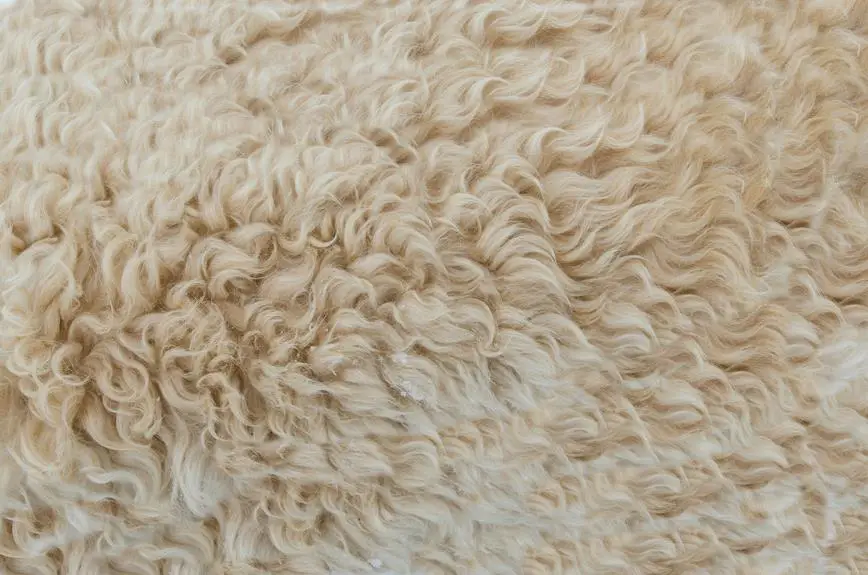You've likely come across poly tricot fabric in your daily life, whether it's in clothing, upholstery, or medical equipment. Its smooth, synthetic surface often leads to claims of being hypoallergenic. But is that really the case? As you explore the world of poly tricot, you may be surprised to learn that its hypoallergenic status isn't as clear-cut as you thought. While it's true that synthetic fibers can reduce the risk of allergic reactions, other factors like chemical treatments, friction, and individual sensitivities can still cause skin irritation. So, what's the real story behind poly tricot's hypoallergenic claims?
Table of Contents
What Is Poly Tricot Fabric
Poly Tricot is a type of synthetic fabric made from polyester fibers. It's created using a process called tricot knitting, which involves interlocking loops of yarn to form a fabric with a soft, smooth surface.
This unique construction gives Poly Tricot its signature texture and makes it a popular choice for clothing, bedding, and other textiles.
When you wear or use Poly Tricot fabric, you'll notice that it drapes well and has a gentle give. This is because the tricot knitting process allows for a bit of stretch, making the fabric comfortable against your skin.
Poly Tricot is also known for its durability and resistance to wrinkles, which makes it a practical choice for everyday use. Additionally, it's often easy to care for, as it can be machine washed and dried.
Poly Tricot Allergy Causes
While Poly Tricot's softness and durability make it a popular choice, some people may experience skin irritation or allergic reactions when they come into contact with this fabric, prompting the question: what causes Poly Tricot allergies? If you're one of the unlucky ones, you're probably wondering what triggers this reaction.
There are several factors that can contribute to a Poly Tricot allergy.
- Dye or finish used in manufacturing: Some people may be allergic to the dyes or finishes used to treat the fabric, which can cause skin irritation or an allergic reaction.
- Weave or texture: The tight weave or smooth texture of Poly Tricot can sometimes cause friction or irritation, especially for people with sensitive skin.
- Moisture retention: Poly Tricot can retain moisture, creating a humid environment that's perfect for bacterial or fungal growth, which can lead to skin irritation or infections.
- Individual sensitivities: Some people may be more prone to allergic reactions due to individual sensitivities or allergies to certain materials.
Synthetic Fiber Composition
When you examine the synthetic fiber composition of poly tricot, you'll want to consider how it's made, what it's made of, and how it's treated.
You'll need to look at the fiber production process, the various material blend options, and the chemical treatment methods used to create the final product.
Fiber Production Process
The production of poly tricot fibers involves a complex process that starts with the creation of a synthetic polymer, typically polyester or nylon, through a chemical reaction that combines petrochemicals with other additives. This process is carefully controlled to ensure the resulting fibers have the desired properties.
The production process involves several key steps:
- Extrusion: The synthetic polymer is melted and formed into a long, thin shape, which will eventually become the fiber.
- Texturizing: The fiber is then texturized to give it a texture similar to natural fibers.
- Cutting: The fiber is cut to the desired length, which can vary depending on the intended use of the poly tricot fabric.
- Drawing: The fibers are then stretched to align the molecular structure, which gives them strength and elasticity.
Material Blend Options
Poly tricot fibers can be blended with other synthetic fibers like polyester, nylon, or spandex to enhance durability, stretch, or texture.
Adding polyester can increase the fabric's wrinkle resistance and easy-care properties, while nylon can boost its strength and abrasion resistance.
However, it's essential to consider how these blends might impact the fabric's hypoallergenic qualities. Some synthetic fibers, like nylon or polyester, can be more prone to pilling or generating microplastics, which might irritate sensitive skin.
Blending poly tricot with fibers like spandex or elastane can create a more breathable and moisture-wicking fabric, reducing the risk of skin irritation.
Chemical Treatment Methods
Considering the synthetic composition of poly tricot fibers, you'll want to examine the chemical treatment methods used to produce them, as these processes can significantly impact their hypoallergenic properties.
As you delve into the world of poly tricot production, you'll discover that various chemical treatments are employed to enhance the fibers' durability, wrinkle resistance, and stain repellency.
These treatments can introduce potential allergens and irritants into the fabric. One process in use includes
Chemical application
during
fabrick producty, processes callechemical are differentninsChem duringprodu * appliedT wex: Finishing treatments: Chemicals like formaldehyde, quaternary ammonium compounds, and alkylphenol ethoxylates are applied to the fabric to give it wrinkle-resistant, stain-repellent, and anti-static properties.
Another is chemical dyeing and printing The use of synthetic dyes and printing agents can introduce allergens and skin irritants into the fabric.
Also, Softening agents: Chemicals like silicones and quaternary ammonium compounds are used to soften the fabric, but can also cause skin irritation in some individuals.
In addition, Moisture-wicking treatments: Chemicals like polytetrafluoroethylene (PTFE) and polyvinylidene fluoride (PVDF) are applied to the fabric to enhance its moisture-wicking properties, but can also release toxic fumes and particles.
Then there are Antimicrobial treatments: Chemicals like triclosan and silver nanoparticles are used to prevent bacterial growth on the fabric, but can also cause skin irritation and allergic reactions.
Poly Tricot Hypoallergenic Claims
Manufacturers often claim that poly tricot is hypoallergenic, but you might wonder what evidence supports these assertions. When you look into it, you'll find that some manufacturers base their claims on the fact that poly tricot is made from synthetic fibers, which are less likely to harbor allergens like dust mites, mold, and mildew. Additionally, poly tricot is often treated with chemicals that inhibit the growth of bacteria and other microorganisms that can trigger allergic reactions.
However, you should note that these claims aren't always backed by scientific evidence. While poly tricot may be less likely to harbor allergens, it's not entirely hypoallergenic. Some people may still experience skin irritation or allergic reactions to the synthetic fibers or chemical treatments used in poly tricot.
Furthermore, the term 'hypoallergenic' isn't regulated, so manufacturers can use it freely without meeting specific standards. As a result, you should be cautious when encountering claims that poly tricot is hypoallergenic and consider multiple sources before making a decision.
Skin Irritation Risks Assessed
When you consider the skin irritation risks associated with poly tricot, you'll want to understand what causes irritation in the first place.
You'll also need to recognize the symptoms of an allergic reaction, which can range from mild redness to severe itching and blistering.
Irritation Causes Explained
Friction, moisture, and individual sensitivities can all play a role in triggering adverse reactions to poly tricot.
When you wear clothing made from poly tricot, the fabric can rub against your skin, causing friction that leads to irritation. Additionally, if you tend to sweat a lot or wear poly tricot in humid environments, the moisture can exacerbate the issue.
The constant rubbing of the fabric against your skin can cause irritation, especially in areas like the neck, armpits, and thighs. This is particularly problematic when combined with high humidity or excessive sweating, as the fabric can cling to your skin, increasing the risk of irritation.
Individual sensitivities also play a significant role in skin irritation from poly tricot. Some people may be more prone to skin irritation due to their skin type or allergies. Furthermore, the chemicals used to treat poly tricot fabrics can sometimes cause skin irritation.
Improper washing and drying techniques can damage the fabric, leading to increased friction and irritation.
Allergic Reaction Symptoms
Recognizing the symptoms of an allergic reaction to poly tricot is key to assessing the skin irritation risks associated with wearing clothing made from this fabric.
If you're allergic to poly tricot, you may experience redness, itching, and swelling on the skin that comes into contact with the fabric. You might also notice small, raised bumps or hives, which can be tender to the touch. In severe cases, blisters or rashes may develop, leading to discomfort and pain.
You should pay attention to these symptoms, especially if you've recently started wearing clothing made from poly tricot.
If you experience any of these symptoms, it's essential to remove the offending garment and wash the affected area with mild soap and water. You may also want to apply a topical cream or ointment to soothe the skin and reduce inflammation.
Sensitivity Risk Factors
When you wear poly tricot clothing, you're exposing your skin to various substances that can cause irritation. The sensitivity risk factors include:
- Dye sensitivities: Poly tricot fabrics may be dyed with chemicals that can cause skin reactions, especially if you have allergies or sensitive skin.
- Chemical treatments: Some poly tricot fabrics may undergo chemical treatments, such as wrinkle-resistance or stain-resistance, which can release irritating substances.
- Texture and weave: The texture and weave of poly tricot fabric can also cause irritation, especially if you have sensitive skin or are prone to skin conditions like eczema.
- Moisture buildup: Poly tricot fabrics can trap moisture, creating a warm and humid environment that fosters bacterial and fungal growth, leading to skin irritation.
Safe Use Guidelines Provided
When handling poly tricot, following safe use guidelines is crucial to minimize the risk of allergic reactions and skin irritation, especially for individuals with sensitive skin or allergies.
You should always wash your hands before and after handling poly tricot fabrics to prevent the transfer of bacteria and other allergens. It's also essential to wear protective clothing, such as gloves and a mask, when working with poly tricot to prevent skin contact and inhalation of fibers.
When using poly tricot for clothing or bedding, make sure to follow the care instructions carefully. Wash the fabric in cold water and avoid using harsh detergents or bleach, which can irritate the skin.
You should also avoid wearing poly tricot clothing that's too tight or constricting, as this can cause friction and increase the risk of skin irritation.
Alternative Fabrics Explained
If you're concerned about the potential allergenic properties of poly tricot, you may want to consider alternative fabrics that are known for their hypoallergenic qualities. These fabrics are designed to minimize the risk of allergic reactions and skin irritation, making them a great option for people with sensitive skin.
When shopping for hypoallergenic fabrics, you'll want to look for materials that are breathable, gentle, and resistant to dust mites and other allergens.
- Bamboo fabric: Bamboo is a natural, eco-friendly fabric that's breathable, moisture-wicking, and hypoallergenic.
- Organic cotton: Organic cotton is a great choice for people with sensitive skin, as it's grown without the use of harsh chemicals or pesticides.
- Silk: Silk is a natural protein fiber that's hypoallergenic and gentle on the skin.
- Tencel: Tencel is a sustainable fabric made from wood pulp cellulose, which is breathable, moisture-wicking, and resistant to dust mites.
Frequently Asked Questions
Is Poly Tricot Fabric Safe for Infants' Clothing?
When choosing fabric for infant clothing, you want to ensure it's safe and gentle on their skin. Poly tricot fabric is a popular choice, but you're right to wonder if it's suitable for your little one.
Can I Be Allergic to Only Poly Tricot Fabric?
You're wondering if it's possible to be allergic to only poly tricot fabric? While it's unlikely, you might experience skin irritation or allergic contact dermatitis specifically from poly tricot's manufacturing process or treatments, not the fabric itself.
Is Poly Tricot Breathable for Summer Wear?
You're looking for a fabric that keeps you cool in the summer, and you're wondering if poly tricot fits the bill. Poly tricot is a type of synthetic fabric that's often used in activewear and summer clothing.
How Does Washing Affect Poly Tricot Allergy Risks?
When you wash poly tricot, you're reducing the risk of allergic reactions. Washing removes potential irritants, like dyes or finishes, that can cause skin issues. You're also preventing the buildup of bacteria and odor.
Are There Poly Tricot-Free Athletic Wear Options?
You're looking for athletic wear options that don't contain poly tricot. Fortunately, many brands now offer alternative fabrics like merino wool, bamboo, or Tencel. You can find poly tricot-free activewear for various activities, from running to yoga.
- How Does Ring Spun Cotton Affect Garment Fit and Shape Retention? - August 13, 2024
- What Are the Challenges in Producing Ring Spun Cotton? - August 13, 2024
- Is Ring Spun Cotton Suitable for Plus-Size Clothing? - August 13, 2024







